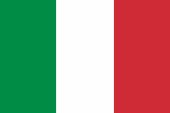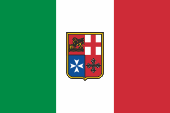
Merchant flag,
ratio = 2:3,
Source, by: Flaggen und Wappen,
Corel Draw 4





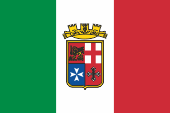
Naval flag,
ratio = 2:3,
Source, by: Flaggen und Wappen,
Corel Draw 4





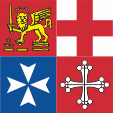
Naval jack,
ratio = 1:1,
Source, by: Flaggen Enzyklopädie,
Corel Draw 4



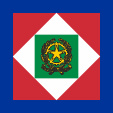
since 2000,
Standard of the president,
Source, by: Flags of the World




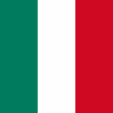
1797–1802,
National flag of the Cisalpine Republic,
Source, by: Flags of the World



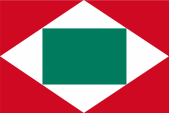
1802–1805,
National flag of the Italian Republic,
Source, by: Flags of the World



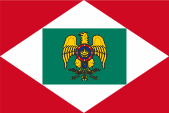
1805–1814,
National flag of the Kingdom of Italy,
Source, by: Von Sodacan Diese Vektorgrafik wurde mit Inkscape erstellt. - Eigenes Werk, CC BY-SA 3.0, Link



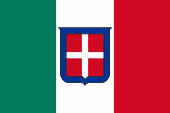
1851–1946,
National- und Merchant flag,
ratio = 2:3,
Source, by: Das Flaggenbuch



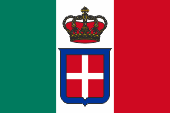
1851–1946,
Naval und war flag,
ratio = 2:3,
Source, by: Das Flaggenbuch



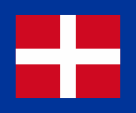
1851–1946,
Naval jack,
ratio = 6:5,
Source, by: Das Flaggenbuch



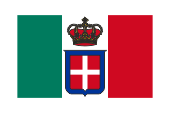
1851–1946,
Pilot jack for war ships,
ratio = 2:3,
Source, by: Das Flaggenbuch



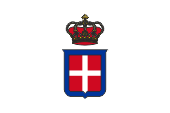
1851–1946,
Flag of the governors of the colonies,
ratio = 2:3,
Source, by: Das Flaggenbuch



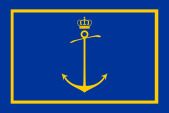
1851–1946,
Flag of the minister of navy,
ratio = 2:3,
Source, by: Das Flaggenbuch



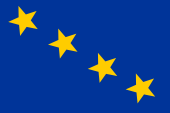
1851–1946,
Flag of the First Admiral,
ratio = 2:3,
Source, by: Das Flaggenbuch



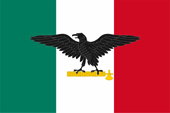
Repubblica Sociale Italiana
1943–1945,
Naval und war flag, without Eagle: national flag
ratio = 2:3,
Source, by: Wikipedia (D)



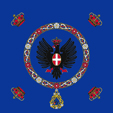
1880-1946,
Standard of the King,
ratio = 1:1,
Source, by: Das Flaggenbuch



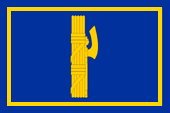
1926–1945,
Flag of the leader Benito Mussolini,
ratio = 2:3,
Source, by: Das Flaggenbuch



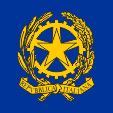
1965–1990, 1992–2000,
Standard of the president,
ratio = 1:1,
Source, by: Flags of the World



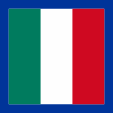
1990–1992,
Standard of the president,
ratio = 1:1,
Source, by: Flags of the World




The flag of Italy shows three vertical stripes in green, white and red. That are originally the cockade's colours of the militia of Milano, which was assumed as national guard (Lombardic Legion) after the French invasion into the Lombardy on the 9th of October in 1796. Napoléon hisself had designed the standard for this unit, as he arranged the colours of the troop like the French tricolor, but just green instead of blue. Already in November 1794 – as a result of the French Revolution and encouraged by the rise of the by Bonaparte commanded French revolutionary troops – rebellious students in Bologna and Milan had created as a distinguishing sign a green-red-red cockade. Ultimately, the colours of the city -white and red- (so in Bologna, Milan and other northern Italian cities) were added by green, as the color of good sense. But Green was not only the color of good sense, but also Napoleon's favorite color. Even in Italy, he had clothed his bodyguards on horseback (the Guids of the Consul) in green and as the Guids then became the hunters on horseback of the imperial guard, they wore green hussar dolmans. Even the by Bonaparte hisself weared uniform was green: the smaller uniform of a colonel of the guard hunters on horseback.
The same green-white-green flag – however completed by an allegorical depiction in the middle – was adoped on 7th of January in 1797 for the Cispadane Republic (a French satellite state). The Cispadane Republic got united with the Transpadane Republic to the Cisalpine Republic on 6th of June in 1797. This used since the 11th of May in 1798 the green-white-red tricolor, however without either completion by a coat of arms. After Napoleon renamed the Cisalpine Republic into Italian Republic, he changed the look of the flag on the 20th of August in 1802, as he combined a white and a green rectangle displaced top of one another on a red flag. On 2nd of January in 1804 Napoléon crowned hisself to the French emperor, and one year later to the king of Italy. For the Kingdom of Italy was now adoped again the green-white-red tricolor, however completed in the middle by the royal coat of arms. After the deposition of Napoléon on the 2nd of April in 1814, and after the end of Napoléon's Kingdom of Italy got the green-white-red tricolor abolished again, and the separate Italian states used their own flags again.
Within the people the flag nevertheless stood rooted, so that it arised again an again at national uprisings and revolutionar movements. In the war of Sardinia-Piemont against Austria Sardinia-Piemont adoped (powered by the king) the by the coat of arms of the country added Italian flag again on 23rd of March in 1848. The green-white-red tricolor became now to a national symbol. After the king of Sardinia-Piemont (from the house Savoyen) united Italy under his leadership, was proclaimed the Kingdom of Italy on the 18th of March in 1861, and the green-white-red tricolor was – in the middle completed by the coat of arms of Svoyen – adoped as national flag.
On 25th of July in 1943 Mussolini – the Chief of the Italian Government – was overthrowed, and Italy capitulated on 8th of September in 1943 toward the allies. Mussolini withdrawed in the by German troops occupied north of the country and proclaimed the "Italian Social Republic" in the Town of Salò. This state used likewise the Italian tricolore, but supplemented by the portrayal of a black eagle which held a golden Liktor bundle in the claws. With the murder of Mussolini by communist partisans (28th of April 1945) ended this staate.
On the 12th of June in 1946 they decided by plebiscite for the abolition of the monarchy, and in this way was removed the Savoyic coat of arms on the from the flag of the now Italian Republic 19th of June in 1946. To prevent confusions with the flag of Mexico was adoped a special blazon for the merchant flag and even the naval flag on the 9th of November in 1947. It shows in quarters heraldic elements of the towns Venice, Genova, Amalfi and Pisa, the importantst seafaring states in the historic Italy. The today's jack of Italy is a scutcheon flag, which has it's roots in this shield.
The colours of the Italian flag, apart from white, green and red, have been defined since 2006 as Pantone Green 17-6153 TCX (Fern Green) and Pantone Red 18-1662 TCX (Flame Scarlet), which roughly corresponds to Pantone 347 and Pantone 711. Since 2003, Italy has been trying to make the colours a little warmer and friendlier and has adapted the shades in 2003 and 2006.
Source: Flags of the World,
Die Welt der Flaggen,
Flaggen Wappen Hymnen,
Flaggen und Wappen der Welt,
Jürgen Kaltschmitt,
Wikipedia (DE)


1861–1946,
Coat of arms of the Kingdom of Italy,
Source, by: Das Flaggenbuch
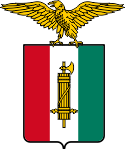
Repubblica Sociale Italiana,
1943–1945,
Coat of arms of the Social Republic of Italy,
Source, by: Wikipedia (D),
Jürgen Kaltschmitt

since 1946,
Coat of arms of Italy,
Source, by:
Corel Draw 4

since 1947,
Scutcheon in the merchant flag,
Source, by:
Flaggen und Wappen
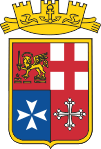
since 1947,
Scutcheon in the naval flag,
Source, by:
Flaggen und Wappen

The today's coat of arms of the state was adoped after long lasting debates on the 5th of May in 1948. It shows a red bordered white star (state, people) on a sprocket (work), surrounded by a oil tree twig (force)- and an oak twig (will for peace). The red saying ribbon below shows the official denomination of the state "Repubblica Italiana". Sometimes get the oil tree twig and the oak twig connected with South Italy resp. North Italy. The coat of arms of the Kingdom of Italy showed the blazon of the Savoy house, a blue bordered shield with a white cross in the middle. Above that the Italian king's crown.
Source: Flags of the World,
Die Welt der Flaggen,
Flaggen Wappen Hymnen,
Flaggen und Wappen der Welt,
quirinale.it
The Social Republic of Italy, which existed under Mussolini from September 1943 to May 1945, had its own coat of arms. It showed a shield in the national colors red, white and green and in the middle a bundle of rods, also called lictor's bundle, and a golden eagle above the shield. The "fascis" (= hatchet) in the bundle of rods was the symbol of the state power in ancient Rome, it was carried forward to the the highest officials, the "lictors". The bundle of rods symbolized the "unity of the many (Roman) citizens who together form a single strong (tree) trunk". The hatchet stands for the violence of the judiciary, which can also give death sentences, but not against Roman citizens. For this reason, only the bundles of rods were carried forward to the officials, without the hatchets, in the area of the city of Rome. In the district around Rome it was used, of course, with hatchets, since Latin law was applied here. Mussolini chose the bundle of rods with hatchet like it had been used in republican Rome, with the ax blade and ax stick protruding from the bundle above and below. It was only in imperial Rome that the "fasces" were shown, which showed the axially protruding ax blade, like the royal Italian air force until July 1943, then again from September 1943 by the national republican air force. Mussolini wanted to emphasize that the fascism in the new republic has returned to its original republican, social(istic) and anti-clerical ideals.
Source: Jürgen Kaltschmitt

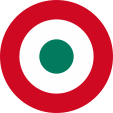
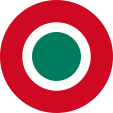
since 1945,
Aircraft roundel,
Source, by: Wikipedia (EN)
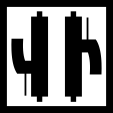
1943–1945,
Aircraft roundel,
Source, by: Wikipedia (EN)
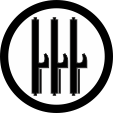
1926–1943,
Aircraft roundel,
Source, by: Wikipedia (EN)


Already in November 1794 – as a result of the French Revolution and encouraged by the rise of the by Bonaparte commanded French revolutionary troops – rebellious students in Bologna and Milan had created as a distinguishing sign a green-red-red cockade. Ultimately, the colours of the city -white and red- (so in Bologna, Milan and other northern Italian cities) were added by green, as the color of good sense. But Green was not only the color of good sense, but also Napoleon's favorite color. Even in Italy, he had clothed his bodyguards on horseback (the Guids of the Consul) in green and as the Guids then became the hunters on horseback of the imperial guard, they wore green hussar dolmans. Even the by Bonaparte hisself weared uniform was green: the smaller uniform of a colonel of the guard hunters on horseback.

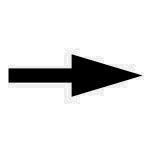



In the years 1804-1805, the cockade was officially changed in green-white-red, which could not be fully achieved (in the same way like in France itself), because the old and experienced soldiers preferred to keep the old cockade, with the intention to distinguish themselves from the inexperienced newcomers with the new cockade.

After the era of Napoléon , the Italian national state was abolished in 1814/1815 – on the occasion of the Congress of Vienna – and the conditions of the pre-Napoleonic period were restored. In the national revolution of 1848/1849, the color combination of green, white and red were remembered again. However, the state of Italy did not arise again until the years 1860/1861, and the green-white-red flags and cockades were reintroduced an keeped valid until today. Here you can find more informations about cockades, and all about the cockade ← click here.
Source: Jürgen Kaltschmitt, Volker Preuß

Position:
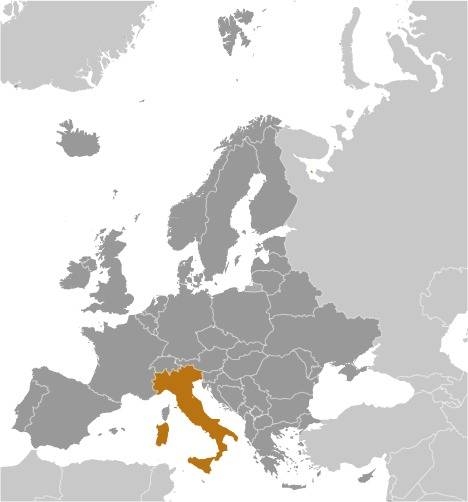
Source: CIA World Factbook
Map of the Country:
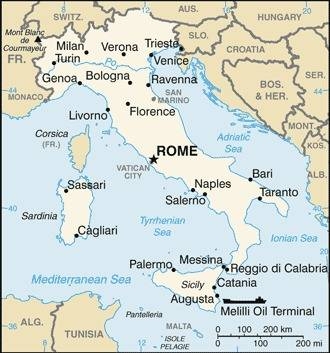
Source: CIA World Factbook
Historical States in Italy, ca. 1850–1858:
all state denominations in English
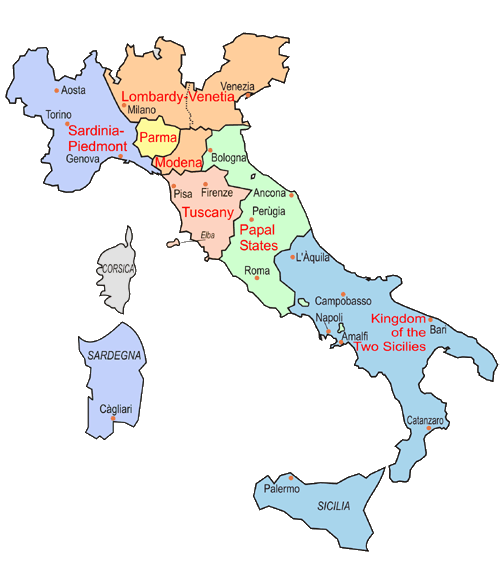
Source: Volker Preuß
today's Regions of Italy:
all denominations in Italian
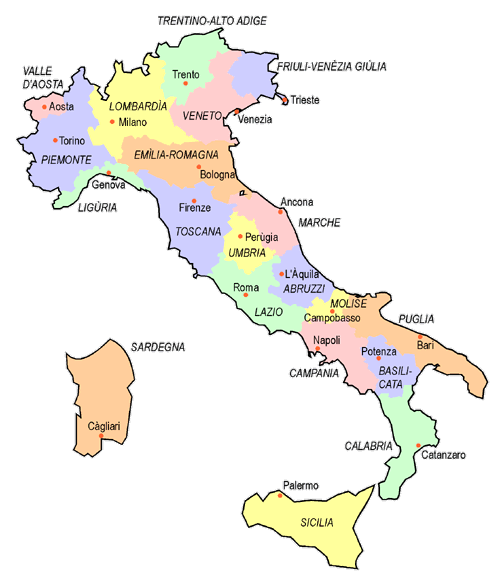
Source: Volker Preuß

Area: 301.338 km²
Inhabitants: 60.502.000 (2017), davon 95% Italiener, 2,6% Sardinier (Sarden), 1,2% Rätoromanen, 0,5% Deutsche
Density of Population: 201 Ew./km² (2017)
Religions: 85% Katholiken, 2% Orthodoxe Christen, 2% Moslems, 1% Protestanten, 7% Nicht-Religiöse
Capital: Rom (Roma), 2 875 000 Ew. (2016)
official Language: Italienisch
regionale official Languagen: Deutsch, Ladinisch, Französisch, Slowenisch
other Languages: Albanisch, Frankoprovenzalisch, Furlanisch, Griechisch, Katalanisch, Molisekroatisch, Okzitanisch, Sardisch
Currency: 1 Euro (€) = 100 Cent
Time Zone: GMT + 1
Regionen: Abruzzen, Aostatal, Apulien, Basilicata, Emilia-Romagna, Friaul-Julisch Venetien, Kalabrien, Kampanien, Latium, Ligurien, Lombardei, Marken, Molise, Piemont, Sardinien, Sizilien, Toskana, Trient-Südtirol, Umbrien, Venetien
Source: Wikipedia (D),
bpb.de

Antike · Besiedelung des heutigen Italiens durch verschiedene Völker, die to 200 v.Chr. im aufstrebenden Römischen Reich geeint werden
400–410 · Invasionen der West Goten
440–460 · Vandaleneinfälle
452 · Hunneneinfälle
476 · Absetzung des letzten römischen Kaisers Romulus Augustulus, Ende des (West)Römischen Reiches, Italien bildet to 493 des Reich des Odoaker
434-540 · Eroberung durch Byzanz (Ostrom)
568/569 · Eroberung durch die Langobarden
774 · Eroberung durch die Franken, Eingliederung von Norditalien in das Frankenreich der Karolinger, Süditalien kommt unter fränkische Oberhoheit
843 · bei der Teilung des Frankenreiches entsteht das Königreich Italien
888 · Aussterben der Karolinger, Italien zerfällt meist in Kleinstaaten
961 · Otto I. bringt fast ganz Italien an das Deutsche Königreich
1130 · Vereinigung Siziliens mit Unteritalien zum Königreich Sizilien, der Norden verbleibt beim Römisch-Deutschen Reich
12.–18th cent. · die Geschichte Italiens ist durch viele Einzelstaaten (hier klicken) und Machtkämpfe zwischen ihnen geprägt, ausländische Mächte mischen sich häufig ein (Spanien, Frankreich, Deutschland, Österreich)
1796 · Italienfeldzug Napoléons, in Italien entstehen zunächst kurzlebige Republiken (hier klicken), die in Folge oft als Monarchien von Napoléons Verwandten regiert werden
1815 · Wiener Kongress, meist Wiederherstellung der alten Verhältnisse aus der vor-napoléonischen Zeit
1830 · die nationale italienische Revolution scheitert
1848–1849 · in fast ganz Italien Aufstand der Volksbewegung "Giòvane Itàlia" unter Mazzini und Garibaldi, Karl Albert von Sardinien-Piemont stellt sich an die Spitze der Erhebung und führt in seinem Land eine liberale Verfassung ein, die Erhebung endet in Uneinigkeit, Karl Albert dankt zugunsten seines Sohnes Viktor Emanuel II. ab
1859–1860 · Feldzüge des Königreichs Sardinien-Piemont gegen ausländische Mächte und weiter, hin zur Einigung Italiens
1860–1861 · Garibaldis Feldzüge gegen verschiedene Einzelstaaten in Italien zur Einigung Italiens
17.03.1861 · Krönung von Viktor Emanuel II. von Sardinien-Piemont zum König des Königreichs Italien
1889 · Italien erwirbt die Kolonie Somaliland
1890 · Italien erwirbt die Kolonie Eritrea
1912 · Italien erwirbt die Kolonie Dodekanes (Rhodos)
1915 · Italien erwirbt die Kolonie Libyen
1915–1918 · Beteiligung Italiens am Ersten Weltkrieg, Gebietsgewinne an österreichischem Territorium
1922 · Benito Mussolini wird Regierungschef ("Duce") und installiert das Faschistische Regierungssystem
1935 · Italien erwirbt die Kolonie Äthiopien
1940–1945 · Beteiligung Italiens am Zweiten Weltkrieg, Gebietsverluste an Jugoslawien und Griechenland, Verlust aller Kolonien, außer Somaliland
02.06.1946 · Volksabstimmung zugunsten der Abschaffung der Monarchie, Proklamation der Italienischen Republik
1951 · Belgien, Deutschland, Frankreich, Italien, Luxemburg und die Niederlande, gründen die EWG (die spätere EU)
Source: Atlas zur Geschichte,
Wikipedia (DE),
Discovery '97,
Weltgeschichte,
Länder der Erde

About the origin of the name of Italy exist some theories: The name Italy goes back to an ancient hero, he was called "Italus". The roots of the name are to be found in the ancient people of the Vitals, who lived in Liguria. The name derives from the word "viteliu". Thus called the Oskers, who lived before the Romans in the south of the Italian peninsula, a young bull. As "vitello", finely sliced veal, it is still to be found on Italian menus.
Sources, 1) & 2): Handbuch der geographischen Namen,
3): PM-Magazin - Wie die Länder zu ihrem Namen kamen


Kindly supported by:

and Jürgen Zens (D), Jürgen Kaltschmitt (D)
![]()

